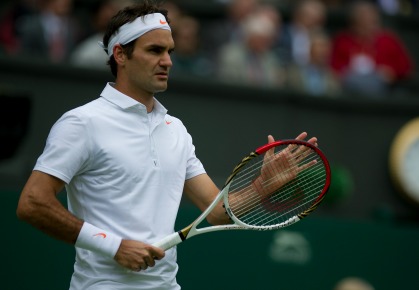|
By Blair Henley
June 27, 2013
|
 WIMBLEDON, England --
WIMBLEDON, England -- Given the words thrown around on day three at Wimbledon – carnage, destruction, slaughter, bloodshed – it was easy to temporarily forget that I am not, in fact, a wartime reporter.
The scene in the pressroom as players went down on the grass, literally and figuratively, was as chaotic as things get at Wimbledon, with journalists and photographers speed-walking from their desks to the courts to the interview room and back again. As soon as I directed my attention to one dramatic loss or injury, I heard murmurs of another unfathomable collapse.
This is the first time I’ve covered Wimbledon from the All England Club, and as a relative rookie here, it was nice to hear from veteran colleagues that they, too, were shell-shocked. Journalists who’ve covered 25-plus Wimbledon events were shaking their heads in disbelief. At some point in the evening, words became unnecessary. We just exchanged understanding looks in the halls. Some even had an extra beer in the well-appointed press restaurant.
Theories on just how such a string of unfortunate events could have coincided on an otherwise beautiful London day were in bountiful supply. Some blamed the grass, much to the dismay of the brand
new groundskeeper at Wimbledon. Some blamed the lack of preparation time on the surface. Some suggested only half jokingly that it was a British conspiracy designed to help Andy Murray and/or Laura Robson claim the title.
And while the kill-count by day’s end stood at seven singles withdrawals and six losses for former No. 1s, nothing could have prepared us for the pièce de résistance: Roger Federer’s defeat at the hands of a serve-and-volleying Sergiy Stakhovsky.
While it may seem dramatic or alarmist, it did truly feel like an era was ending. With the loss, Federer’s ranking will drop outside the top four for the first time in a decade. Perhaps even more unbelievable is David Ferrer’s rise to No. 3, but that’s a story for a different day. Of course, most of the chatter involved the end of Federer’s streak of reaching 36 consecutive Grand Slam quarterfinals.
As soon as the press conference times were announced after that final match on Centre Court, I hurried down to the interview room to grab a seat. A dreary pall hung over the capacity crowd of reporters and photographers. There was a sense of loss, no doubt. Not just Roger’s loss, but the loss of the Federer name from the draw, his aura from the grounds.
Once he arrived, clad in a striped Nike tee and jeans, the questions began. I asked whether the end of the quarterfinal streak might actually lessen the pressure he feels moving forward.
“Not really,” he said. “I wish it did. It doesn't feel that way right now.”
After explaining his disappointment (in several different ways), Federer also added that he has plans to play for “many more years.” Part of me couldn’t help but think he was lying through his teeth. Any sports superstar would be silly to muse publicly about the end of his or her career unless they enjoy being asked about it incessantly. I hope I’m wrong.
At Wimbledon, where order and predictability are everything, “Black Wednesday” will forever stand out in the tournament’s storied history. But, as expected, that bizarre chain of events hasn’t put a damper on the crowds, the enthusiasm or the atmosphere at the All England Club. People here clearly come for the tennis, not necessarily the big names.
|
(Photo Credit: Stephen White/CameraSport) |